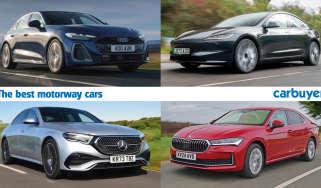Hyundai Veloster coupe (2011-2014)
"Practical, good looking, well equipped and fun to drive - the Hyundai Veloster is an attractive package."
Pros
- Clever door layout
- Good value for money
- Fun to drive
Cons
- Limited headroom
- Slightly underpowered
- Hyundai badge can't match Volkswagen for image
The Hyundai Veloster was sold in the UK between 2011 and 2014, and at the time of writing hasn't been replaced. It's a practical coupe that competes with models such as the Volkswagen Scirocco but is much cheaper to buy. The Hyundai also features a rather unusual door layout, with two doors on the passenger side and one on the driver side. Unlike in the original MINI Countryman, this door opens on to the pavement in the UK, so kids don’t have to exit the car onto the road.
From launch the Hyundai was available with just one engine – a sluggish 1.6-litre petrol, but the arrival of a new 1.6-litre turbo means that the Hyundai has the pace to back its coupe image, even if it still isn’t super-quick. It may not be as fast as some coupe buyers would like but it is fun to drive on a twisty road.
There’s a choice of two models – the SE and the Turbo. Both models come well equipped with items such as a seven-inch touchscreen, a rear-view camera, air-conditioning and LED daytime running lights.
MPG, running costs & CO2
While the Hyundai Veloster isn’t hugely expensive to run, its petrol engines can’t compete with the latest small-capacity units offered by the likes of Volkswagen in its Scirocco or even the latest MINI Hatchback Cooper, which is likely to appeal to people in the market for a Veloster. The Hyundai also isn’t available with a diesel engine.
The cheapest model to run in the Veloster range is the 1.6-litre petrol without a turbo, which can return up to 43.5mpg and emissions that mean it costs £145 a year to tax. The turbocharged 1.6-litre engine, meanwhile, can do 40.9mpg and emit 157 g/km of CO2 for annual road tax of £180.
Hyundai also offers fixed-price servicing over three or five years, which means you can keep on top of maintenance bills.
Engines, drive & performance
The Veloster has a stiff suspension that makes it less comfortable than some of the car’s rivals but it does keep body lean in the corners to a minimum and the Veloster is fun to drive as a result.
The problem is that neither of the Veloster models is particularly quick, bearing in mind this is supposed to be a fast coupe. The basic car is the worst offender, getting from 0-60mph in 9.7 seconds, which in real-life driving situations means you often have to change down two gears to make safe overtakes. The car does have a top speed of 125mph though, so motorway cruising is reasonably comfortable and refined.
The Turbo model isn’t a lot better, getting from 0-62mph in 8.4 seconds on the way to a top speed of 133mph. The extra power available does mean that you won’t have to change gear as much as you do in the SE model.
Interior & comfort
The Hyundai feels sporty to drive but the trade off is a ride that’s jittery on the UK’s bumpy roads and cars such as the Scirocco and the Vauxhall Astra GTC will be more comfortable on a long journey.
That said, the Veloster gets comfy sports seats and both models have driver’s seats that adjust for height, and steering wheels that move for rake and reach, so getting a good position behind the wheel shouldn’t be a problem.
Practicality & boot space
The Hyundai Veloster offers something no other coupe does – a single rear passenger door. That means access to the back is better than normal for a car of this type, although if you want to get to the far side of the rear seat you’ll still have to slide along the rear bench. The rear door also gives excellent access if you need to fit a child seat. In the back there is a decent amount of legroom and headroom, especially when you consider the Hyundai’s sloping roofline.
Space in the front is generous, too, and Hyundai hasn’t held back on cabin storage – all Velosters get a glovebox, door bins, two cupholders between the front seats, a centre cubby, and a lidded storage area under the central armrest.
Boot space is decent, too, and the Hyundai offers 320 litres of luggage capacity, and split-folding rear seats that drop down to reveal 984 litres in total.
Reliability & safety
The Hyundai Veloster hasn’t featured in our Driver Power owner satisfaction survey, but Hyundai has got a reputation for good build quality and we wouldn’t foresee any problems. Even if something does go wrong, Hyundai offers one of the best warranties in the business and the car is covered for five-years or 100,000 miles (whichever comes first).
The coupe was crash tested for safety by Euro NCAP in 2011 and achieved five stars. It gets six airbags, a seatbelt warning buzzer in the front, ISOFIX child seat mounts, and electronic stability control.
Price, value for money & options
The Hyundai might not have the same quality of finish as a Volkswagen, but it is well equipped. All models get 18-inch alloy wheels and air conditioning. The top-spec Turbo gets an impressive list of kit including touchscreen sat-nav, keyless entry and go, automatic headlights and wipers, plus heated front seats.












